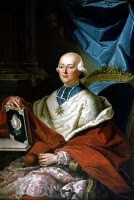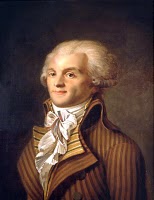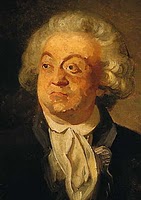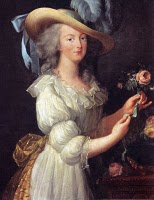Epilogue: The Reign of Terror Meets its Own End
 Monday, September 12, 2011 at 8:44AM Tweet
Monday, September 12, 2011 at 8:44AM Tweet  2 Days Remain In Charlotte's
2 Days Remain In Charlotte's
Kickstarter Campaign
Now 112% Funded
But It's Never Too Late To
Pledge Your Support!
The French people of 1793 did not immediately share Charlotte’s views regarding her sacrifice. They did not see her as a martyr; nor did they take Marat for a madman. It was Marat’s body, not Corday’s, that received a hero’s funeral. His body was placed in a proper coffin, paraded through the streets of Paris to the sound of weeping citizens, and buried at the Pantheon.
Charlotte’s headless remains, in contrast, were tossed among those of the other victims of the Revolution into an open, pestilent, public grave.
What’s more, Charlotte’s murder of Marat cast a long shadow of doubt over the remaining Girondin delegates to the National Convention. Already in trouble for standing against the king’s execution, they were believed by Robespierre and the other Jacobins to have been in cahoots with young Corday, even though she repeatedly insisted that they were not. Indeed, their presumed collaboration was never proven. However, all 21 Girondin delegates were put to death, just as Marat had wanted, on 29 October 1793.
 Marie Antoinette, Queen of France, would beat the 21 Girondins to the guillotine by a mere two weeks.
Marie Antoinette, Queen of France, would beat the 21 Girondins to the guillotine by a mere two weeks.
Not quite six months after losing her husband on 21 January 1793, she also lost her son, eight-year-old Louis Charles, heir apparent to the French throne. Exiled Royalists had declared the boy King Louis XVII upon his father’s death, so the revolutionaries took him from the bereaved wife and mother and placed him in solitary confinement to keep him from being rescued. He died in captivity at the age of ten.
In the early hours of 2 August 1793, just two weeks after the death of young Charlotte Corday, Marie Antoinette was removed from her sister-in-law, Madame Elizabeth, and her daughter, Marie Thérèse, then aged 15. The queen bade farewell to her first born, instructing her to obey her Aunt as she would a mother.
Marie Antoinette was then spirited away through the sleeping Paris streets to the Conciergerie Prison, with no crowds to hamper the progress of the carriage, and no witnesses.
 On 14 and 15 October 1793, the Queen of France stood before the Revolutionary Tribunal as ‘Prisoner no. 280’, aged well beyond her almost 38 years. She was accused of treason, aiding the enemy, and inciting a civil war.
On 14 and 15 October 1793, the Queen of France stood before the Revolutionary Tribunal as ‘Prisoner no. 280’, aged well beyond her almost 38 years. She was accused of treason, aiding the enemy, and inciting a civil war.
The very next day, 16 October 1793, Charles Henri Sanson arrived at work early to cut the queen’s hair and bind her hands behind her back. She was loaded onto a tumbrel, made to sit with her back to the horses, and paraded through the streets of Paris before reaching the Place de la Revolution.
The day was fine and warm for the season. Huge crowds lined the route to Madame La Guillotine. Shouting “Long Live the Republic”, they spat on the queen’s cortège. Marie Antoinette rode to her death calm, composed, and courageous.
Her head was cut clean at 12:15 and unceremoniously dumped, along with her body, into a common grave. She had endured more than two months incarceration in the humid and airless Conciergerie, where she lacked all privacy - guarded both night and day - even for the most private of ministrations.
Two weeks after the fall of the Girondins, on 6 November 1793, cousin Philippe-Egalité also met his end at executioner Sanson’s blade. As many as 20,000 people, many innocent of any real crime, lost their lives during the Reign of Terror of the French Revolution.
* * *
By 1795, the French people were tired of the bloodshed. They realized, like Charlotte, that the promise of Liberty, Equality, and Fraternity that the Revolution once represented had long since been lost. The most radical revolutionaries now began to turn on each other. One-by-one, they, too, found their place at the base of Madame La Guillotine.
• Camille Desmoulins: Executed, 5 April 1794
• Georges Danton: Executed, 5 April 1794
• Maximilien Robespierre: Executed, 28 July 1794
• Antoine Quentin Fouquier-Tinville: Executed, 7 May 1795
 With no one, neither Royalist nor Republican, left to run the country, power now shifted to the French Army and, in particular, to a promising young general who had already distinguished himself in battle against the Austrian and Prussian Empires. He was a young Corsican lad, who went by the name of...
With no one, neither Royalist nor Republican, left to run the country, power now shifted to the French Army and, in particular, to a promising young general who had already distinguished himself in battle against the Austrian and Prussian Empires. He was a young Corsican lad, who went by the name of...
NAPOLEON BONAPARTE
Please join us for the next story in the Time Traveler Tours Paris series:
Day of the Dead, The Napoleonic Era, 1799-1815.
Listen to Charlotte tell her story in her own words.
Download her StoryApp here.
Images:
Unknown. Bust of Marat, 18th c. Crédit photographique: Musée de la Révolution Françaises, Vizille, France, http://www.domaine-vizille.fr, Inv. MRF 1988-112.
Unknown. Marie Antoinette, Queen of France (1755-1793) in Prison. Photographic reproduction of original [LC-USZ62-116784], courtesy of the Library of Congress Prints and Photographs Division Washington, D.C. 20540 USA.
Unknown. Trial of Marie Antoinette of Austria, 18th c. Crédit photographique: Musée de la Révolution Françaises, Vizille, France, http://www.domaine- vizille.fr, Inv. MRF 1983-323.
David, Jacques Louis (1748-1825). Napoleon I crossing the Alps at St. Bernard. Photomechanical print reproduction of original [LC-USZC4-7159], courtesy of the Library of Congress Prints and Photographs Division Washington, D.C. 20540 USA.























 Simultaneously, the King saw an opportunity to get back at Britain for his grandfather’s humiliating loss in the Seven Years War. He agreed to send troops and aid totaling 2,000 million livres to support the American revolutionaries. In the 1770s this sum could have fed and housed 7 million French citizens for a year. With France already teetering on financial collapse, this expenditure was seen by many as irresponsible. Indeed, it would have a calamitous effect on the French economy.
Simultaneously, the King saw an opportunity to get back at Britain for his grandfather’s humiliating loss in the Seven Years War. He agreed to send troops and aid totaling 2,000 million livres to support the American revolutionaries. In the 1770s this sum could have fed and housed 7 million French citizens for a year. With France already teetering on financial collapse, this expenditure was seen by many as irresponsible. Indeed, it would have a calamitous effect on the French economy.




 Joseph and Etienne thought it best to send animals aloft first! On September 19, they sent a duck, a rooster, and a sheep called Montauciel (Climb-to-the-sky) into the skies of Versailles before a huge crowd, including the King and Queen Marie-Antoinette. The flight lasted roughly eight minutes and covered 3.3 kilometers (2 miles), obtaining an altitude of 462 meters (1500 ft). The animals survived the trip unharmed; indeed, Montauciel was found nibbling unperturbed on the straw used to fuel the fire that lifted the balloon.
Joseph and Etienne thought it best to send animals aloft first! On September 19, they sent a duck, a rooster, and a sheep called Montauciel (Climb-to-the-sky) into the skies of Versailles before a huge crowd, including the King and Queen Marie-Antoinette. The flight lasted roughly eight minutes and covered 3.3 kilometers (2 miles), obtaining an altitude of 462 meters (1500 ft). The animals survived the trip unharmed; indeed, Montauciel was found nibbling unperturbed on the straw used to fuel the fire that lifted the balloon.

